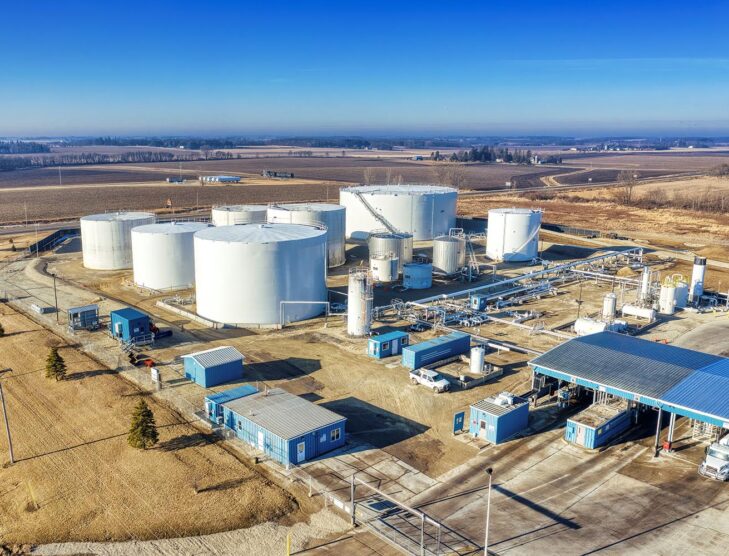
Calculating carbon footprint along the chemical supply chain
There has been an acceleration in commitments to decarbonise from organisations throughout the globe. No longer is carbon neutrality the realm of first movers looking to become role models or to gain a business advantage. Active decarbonisation is quickly becoming a license to operate and the business case for measuring and managing emissions within supply chains is becoming increasingly robust.
The chemical industry is one of the highest emitting categories, accounting for an estimated 7% of global greenhouse gas (GHG) emissions, according to Together for Sustainability (TfS). Chemical supply chains are exceptionally complex and obtaining data on Scope 3 emissions can be very challenging. Scope 3 emissions are the result of activities from assets not owned or controlled by the reporting organisation. 77% of chemical industry emissions are in Scope 3. Addressing Scope 3 emissions is critical to climate mitigation strategies in the chemical sector and customers are demanding greater supply chain transparency across all industries.

Until recently, calls for a harmonised approach to calculating supply chain emissions appeared to fall on deaf ears. However, TfS, a joint initiative of chemical companies committed to building sustainable chemical supply chains and responding to society’s needs, just published global guidance for calculating Product Carbon Footprints (PCFs) in the chemical industry. Founded in 2011, TfS comprises 37 member companies with a combined annual turnover of EUR500 billion (USD484 billion).
The PCF Guidance is the “first-of-its-kind,” says TfS, and the organisation believes it can revolutionise the way emissions data is captured and reported. The guidance provides a consistent way of generating product-level information for the identification and tracking of Scope 3 GHG emissions and simplifies the sharing of information throughout the supply chain, they say.
Described as the “gold standard” for producing quality carbon footprint data, the PCF Guideline incorporates commonly used international standards and practices, is fully ISO (International Organization for Standardization) compliant and is accepted by the GHG Protocol, which establishes comprehensive global standardised frameworks to measure and manage GHG emissions from private and public sector operations, value chains and mitigation actions. Independent global service provider, TÜV Rheinland Energy GmbH, was responsible for validating compliance with existing certifications.
The document is the result of a collaboration with non-governmental organisations (NGOs), corporate sustainability and chemical industry experts, and several organisations including the World Economic Forum (WEF) and the World Business Council for Sustainable Development (WBCSD).
“Until now, the chemical industry has lacked a common approach to calculating its Product Carbon Footprints. The availability of PCF data is limited, and calculations are often not directly comparable. The new PCF bridges this gap, offering a harmonised way to generate and share information on the emissions arising from chemical supply chains,” said Professor Peter Saling, director of sustainability methods at BASF and lead of the TfS Guideline Work Package. TfS believes the guidelines will simplify cross-industry comparisons and contribute to developing a high-quality industry baseline.

The guidelines were released in September 2022 and are available for download. However, the initial publication includes only chapter five of the document, which is primarily focused on outlining the PCF specifications. Chapter five has been fast-tracked due to an “urgent need” for a harmonised PCF calculation, says TfS.
Four additional chapters will be published in November 2022 which include reporting principles and guidance on scope 3 calculation at a corporate level. In addition, the not-for-profit organisation has announced that an IT solution is being developed that will enable straightforward sharing of PCFs at scale between corporations and suppliers. The IT solution is due to be released in the latter half of 2023.
WBCSD and TfS are also planning an interactive virtual event in November 2022 to outline the importance of the drop-in solution and to offer details on the calculation of corporate inventories using supplier-specific data. The session will include feedback from cross-sector sustainability leaders involved in the PCF pilot programme.
PCF Guidelines draw on the “wealth of expertise and knowledge within the TfS member network” and provide clear instructions on evaluating GHG emissions for specific chemical products in an audit-ready format. The guidelines are also “open source,” which TfS hopes will encourage their application in other industries utilising chemical materials.
It seems that TfS is taking the lead in the chemical industry and product-level assessments have the potential to contribute to transparency along chemical supply chains. However, it is important to note that the PCF Guidelines provide calculations from “cradle-to-gate” as opposed to “cradle-to-grave.” The analysis only includes the extraction, manufacturing and transportation until the product exits the factory gate. Emissions from product use and end-of-life are beyond the scope of analysis—two phases which can produce substantial emissions during the product’s lifecycle.

TfS also noted a limitation that potential trade-offs or co-benefits between environmental impacts can be missed in a GHG-only inventory. A GHG-only inventory should not be used to represent a product’s overall environmental performance, they say.
The guidelines account for GHGs carbon dioxide (CO2), methane, nitrous oxide, hydrofluorocarbons, perfluorinated compounds, sulphur hexafluoride, nitrogen triflouride, perfluorocarbons, fluorinated ethers, perfluoropolyethers, chlorofluorocarbon and hydrochlorofluorocarbon. Emissions are aggregated as CO2 equivalents and individual gases are not reported separately.
Brussels-based TfS also noted that production equipment manufacturing, buildings, infrastructure and other capital goods, business travel and R&D activities are excluded from carbon footprint calculations. As the guidance is product-related, these activities fall outside the boundaries of a cradle-to-gate PCF.
Verification of PCF data before sharing is required to maintain the integrity of the data. The type of verification must be reported alongside the PCF. An internal lifecycle analysis expert, a third-party product review, or an independent party verification are all potential options, says TfS. In situations where there are discrepancies between declared product category rules (PCR) for the same product from different organisations, TfS will undertake an expert review to declare the “TfS accepted PCR,” with a list of accepted PCRs published and updated annually.
While the documentation for PCF is available now, TfS also outlined additional work being undertaken by TÜV Rheinland Energy GmbH. The German company is assessing the guidelines against all relevant standards applied and is investigating if reporting requirements for applicants are sufficiently defined in the guideline. The company will also test the level of usability and potential areas that can be optimised.







